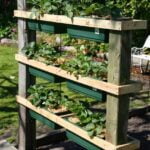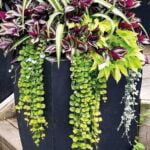Are you looking to create a charming and inviting outdoor space that embodies the rustic charm of farmhouse living? From quaint flower gardens to sprawling front yards, farmhouse landscapes offer a unique blend of natural beauty and functional design.
In this article, we will explore farmhouse landscape ideas that will help you transform your outdoor space into a picturesque haven. Whether you’re drawn to the simplicity of a country garden or the elegance of a manicured estate, incorporating farmhouse landscape ideas can add character and charm to any outdoor setting.
When it comes to farmhouse landscape design, there are some key elements and principles that set it apart from other styles. Understanding the basics of farmhouse landscaping is essential for creating a cohesive and visually appealing outdoor space. From plant selection to hardscaping, color schemes, and outdoor living spaces, each aspect plays a crucial role in capturing the timeless appeal of farmhouse landscapes.
One of the defining features of farmhouse landscapes is their reliance on natural elements and simple yet elegant design choices. This emphasis on organic beauty often includes an array of carefully chosen plants, including vibrant flowers, lush shrubs, and stately trees.
Additionally, incorporating hardscaping elements such as pathways, fences, and other structural features adds both functionality and visual interest to the overall design. As we delve into this article’s various sections, you’ll gain insights into how these components work together to create a truly unique farmhouse landscape.
Farmhouse Landscape Design Basics
When it comes to farmhouse landscape ideas, there are certain key elements and principles that make these designs unique. Understanding the basics of farmhouse landscape design is essential for creating a cohesive and visually appealing outdoor space that complements the style of a farmhouse home.
Rustic Charm
One of the defining characteristics of farmhouse landscapes is their rustic charm. This can be achieved through the use of natural materials such as wood, stone, and reclaimed materials. Incorporating vintage or antique elements into the landscape design can also enhance its farmhouse appeal.
Functional Layout
Farmhouse landscapes are often designed with functionality in mind. This means creating distinct areas for different purposes, such as vegetable gardens, flower beds, and outdoor entertaining spaces. The layout should flow seamlessly while still maintaining a sense of practicality and purpose.
Embracing Nature
Another key principle of farmhouse landscaping is embracing the surrounding natural environment. This can include preserving mature trees, incorporating native plants, and allowing ample green space for a more organic and unstructured feel. The goal is to create a landscape that looks like it has naturally evolved over time.
By understanding these key elements and principles of farmhouse landscaping, homeowners can create outdoor spaces that are not only visually appealing but also in harmony with the architectural style of their farmhouse home. With careful planning and implementation, a farmhouse landscape can exude charm, functionality, and a deep connection to nature.
Plant Selection
When it comes to creating a stunning farmhouse landscape, choosing the right plants is crucial. Whether you’re aiming for a classic, rustic look or a more modern farmhouse feel, the plant selection will set the tone for your outdoor space. From colorful flowers to lush shrubs and stately trees, each plant plays a role in bringing your farmhouse landscape ideas to life.
Flowers
One of the key elements of a farmhouse landscape is an abundance of colorful, blooming flowers. When selecting flowers for your farmhouse garden, consider classic favorites like daisies, sunflowers, and lavender. These cheerful blooms can add a pop of color and whimsy to your outdoor space, creating a welcoming and charming atmosphere.
Shrubs
Incorporating shrubs into your farmhouse landscape can add texture and depth to the overall design. Consider planting shrubs such as hydrangeas or boxwood to create visual interest and structure in your garden beds. These versatile plants can be used to frame pathways, accentuate architectural elements, or create privacy in outdoor living spaces.
Trees
When it comes to adding trees to your farmhouse landscape, consider options that will provide both beauty and functionality. Classic choices like maple or oak trees can offer shade and visual appeal while complementing the natural surroundings. Additionally, fruit-bearing trees like apple or pear can add a touch of rustic charm while providing delicious homegrown produce. Selecting the right mix of flowering trees, evergreens, and fruit trees will enhance the overall aesthetic of your farmhouse landscape design.
Hardscaping
When it comes to creating a beautiful and inviting farmhouse landscape, hardscaping plays a crucial role in achieving the desired aesthetic. Incorporating pathways, fences, and other structural elements into a farmhouse landscape design can not only enhance its visual appeal but also improve functionality and accessibility. From traditional gravel paths to charming picket fences, there are countless hardscaping options to consider when planning your farmhouse landscape.
One of the key elements of hardscaping in a farmhouse landscape is the use of natural materials such as stone and wood. These materials can help create a rustic and timeless look that complements the overall farmhouse aesthetic. For pathways, consider using flagstone or brick pavers for a classic and durable option. When it comes to fences, a white picket fence can add charm and character to the landscape while also defining different areas of the property.
Incorporating structural elements like pergolas, arbors, and trellises can also add dimension and interest to a farmhouse landscape. These features provide support for climbing plants such as roses or ivy, adding texture and color to the outdoor space. Additionally, they can create shaded areas for relaxation or dining, further enhancing the functionality of the landscape.
| Key Elements | Hardscaping Ideas |
|---|---|
| Natural Materials | Stone pathways; wooden picket fences |
| Structural Elements | Pergolas; arbors; trellises |
Color Palette
Color is an essential element in farmhouse landscape design, as it can evoke a sense of warmth, nostalgia, and tranquility. When selecting a color palette for your farmhouse landscape, it’s important to consider the architectural style of the farmhouse itself, as well as the surrounding natural environment. Neutral tones like whites, grays, and beiges are commonly used in farmhouse landscapes to create a timeless and classic look that complements the rustic charm of the property.
In addition to neutral tones, integrating pops of color into a farmhouse landscape can add visual interest and personality. Consider incorporating vibrant flowers such as sunflowers, daisies, or lavender to infuse your landscape with cheerful hues. These colorful blooms can be planted in flower beds or containers near the farmhouse’s exterior to create inviting focal points that draw the eye and enhance curb appeal.
When choosing a color scheme for your farmhouse landscape, it’s important to take into account seasonal changes. While neutrals provide a consistent backdrop year-round, pops of color can be interchanged with seasonal plantings to reflect the changing colors of nature. For example, bold reds and oranges in autumn or pastel pinks and purples in spring can capture the essence of each season.
The careful selection and arrangement of colors in a farmhouse landscape can amplify its charm and beauty while complementing the architectural style of the farmhouse itself. By integrating both neutral tones and pops of color strategically throughout the property, you can create a visually stunning landscape that reflects the timeless appeal of farmhouse living.
| Color Selection | Impact on Farmhouse Landscape |
|---|---|
| Neutral Tones | Creates a classic and timeless look that complements rustic charm |
| Pops of Color | Adds visual interest and personality; enhances curb appeal |
| Seasonal Changes | Reflects changing nature colors through strategic plantings; captures essence of each season |
Outdoor Living Spaces
First and foremost, it’s important to select the right location for outdoor living spaces within the farmhouse landscape. Whether it’s a patio, deck, or outdoor kitchen, positioning these areas to take advantage of natural features such as views or shade can enhance their appeal. In addition, considering factors such as privacy from neighboring properties and proximity to the farmhouse itself can also play a critical role in the design of outdoor living spaces.
Once the location is determined, it’s essential to consider the furnishings and decor that will make these outdoor areas comfortable and welcoming. This may include selecting durable and weather-resistant furniture, incorporating cozy textiles like throw pillows and blankets, and adding lighting for ambiance during evening gatherings. Additionally, integrating elements such as fire pits or outdoor kitchens can elevate the functionality of these spaces for entertaining guests or enjoying meals al fresco.
Overall, creating inviting outdoor living spaces in a farmhouse landscape requires thoughtful planning and attention to detail. By considering the layout, furnishings, and functionality of these areas, homeowners can make the most of their outdoor space while complementing the charming aesthetic of a farmhouse landscape.
- Elements to consider when creating outdoor living spaces:
- Location considerations (views, shade, privacy)
- Furnishings and decor selection
- Functional elements like fire pits or outdoor kitchens
Seasonal Maintenance
For farmhouse landscape ideas, proper maintenance throughout the year is essential to keep the design looking its best. The changing seasons bring different challenges and opportunities for a farmhouse landscape, so it’s important to have a plan in place for winterization and spring planting.
In the winter, it’s crucial to protect the plants and hardscaping elements of a farmhouse landscape from harsh weather conditions. This can include wrapping delicate shrubs in burlap, applying mulch to protect the soil, and clearing pathways of snow and ice. Winterization also involves preparing any outdoor living spaces for the colder months, such as storing patio furniture and covering outdoor kitchens or fire pits.
As spring approaches, it’s time to start thinking about planting new additions to the farmhouse landscape. This may involve selecting colorful flowers and hearty shrubs that will thrive in the upcoming warmer months. Spring is also an opportunity to assess any damage that occurred during the winter and make necessary repairs or replacements. Proper spring planting will set the stage for a vibrant and lush farmhouse landscape throughout the summer and fall seasons.
Overall, seasonal maintenance is key to keeping a farmhouse landscape looking beautiful year-round. By taking proactive steps to protect plants and structural elements during winter and strategically planning out spring planting, homeowners can ensure that their farmhouse landscape remains a stunning feature of their property no matter the season.
Case Studies
In conclusion, farmhouse landscapes offer a unique and charming appeal that sets them apart from other landscaping styles. The combination of natural elements, traditional design principles, and a focus on outdoor living spaces creates a welcoming and picturesque environment that is perfect for any rural or suburban home.
When considering farmhouse landscape ideas, it’s important to understand the key elements and principles of this style. From the selection of plants to the incorporation of hardscaping and the careful consideration of color palettes, each aspect of farmhouse landscaping plays a role in creating the desired aesthetic.
By exploring real-life examples in case studies, homeowners can gain inspiration and ideas for their own farmhouse landscapes. Whether it’s through integrating seasonal maintenance tips or creating inviting outdoor living spaces, these case studies serve as valuable resources for anyone looking to enhance their property with farmhouse landscape ideas. With careful planning and attention to detail, it’s possible to transform any backyard into a stunning farmhouse-inspired oasis that is both functional and visually appealing.
Frequently Asked Questions
How Can I Make My Front Yard Look Elegant?
Making your front yard look elegant can be achieved by maintaining a well-manicured lawn, planting colorful and well-maintained flowers and plants, incorporating stylish outdoor lighting, adding decorative elements like a fountain or sculpture, and keeping the overall design cohesive and balanced.
How Do I Create a Beautiful Landscape on a Budget?
Creating a beautiful landscape on a budget can be done by opting for low-maintenance plants, utilizing locally sourced materials for hardscaping, repurposing old items into garden decor, focusing on one focal point for visual impact, and considering DIY projects for landscaping rather than hiring professionals.
What Makes a Beautiful Front Yard?
A beautiful front yard is characterized by lush greenery and colorful flowers, a well-kept lawn, thoughtfully designed walkways and pathways, clean and attractive hardscaping elements such as fences or retaining walls, adequate but not overwhelming use of outdoor decor, and an overall appearance that complements the architectural style of the home.

Welcome to my gardening blog! I am passionate about plants and enjoy sharing my knowledge and experiences with others. In this blog, I will write about everything related to gardening, from tips on how to get started to updates on my own garden projects.





